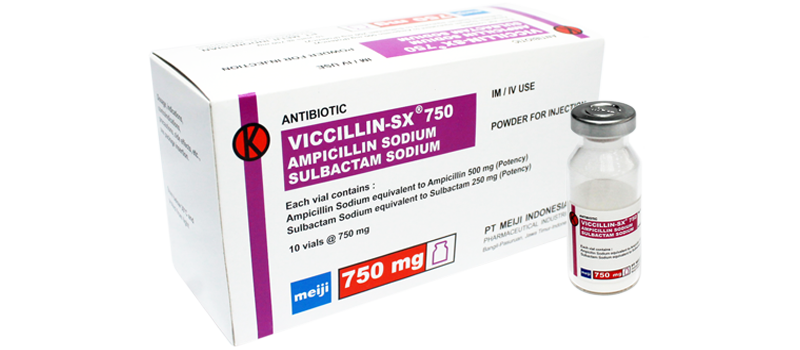|
Indications
Infections caused by susceptible microorganisms. Typical indications are upper and lower respiratory tract infections, including sinusitis, otitis media and epiglottitis; bacterial pneumonias; urinary tract infections and pyelonephritis; intra-abdominal infections including peritonitis; cholecystitis; endometritis and pelvic cellulitis; bacterial septicemia; skin, soft tissue, bone and joint infections and gonococcal infections.
Viccillin-SX powder for injection may also be administrated peri-operatively to reduce the incidence of post-operative wound infections in patients undergoing abdominal or pelvic surgery, in which peritoneal contamination may be present. In termination of pregnancy by caesarean section, Viccillin-SX powder for injection may be used prophylactically to reduce post-operative sepsis.
|
|
Dosage and Administration
AMPICILLIN SODIUM/SULBACTAM SODIUM Powder injection can be administered by intravenous or intramuscular route.
Table 1. Possible dilution
|
Total dose (g)
|
Dose equivalent to
Ampicillin-Sulbactam
|
Packaging (vial)
|
Solvent volume (mL)
|
Maximum final concentration (mg/mL)
|
|
1,50
|
1,0 – 0,50
|
15 mL
|
2,8
|
250 – 125
|
For intra-vena administration, AMPICILLIN SODIUM/ SULBACTAM SODIUM powder for injection have to be diluted with sterile water for injection or compatible solvent, and leave it until no foam shown as visual evidence of complete dilution. Dosage can be administered by bolus injection for at least 3 minutes or higher dilution as bolus or intra-vena infusion for 15 – 30 minutes. Parenteral Ampicillin Sodium/Sulbactam Sodium can also be administered by deep intra-muscular injection; if experiencing pain on injection site, sterile solution of lidocain HCl 0.5% anhydrate for injection can be used as the solvent of the powder.
Usual dosage range: 1.5 – 12 g/day in split dose every 6 – 8 hours until maximum dose of Sulbactam 4 g/day. Non-severe infection can be administered every 12 hours (see table 2).
Table 2. Usual dosage range
| Severity of infection |
Daily dose of AMPICILLIN SODIUM/ SULBACTAM SODIUM
powder for injection (g)
|
Mild
Moderate
Severe |
1,5 to 3 (0,5+1 to 1+2)
until 6 (2+4)
until 12 (4+8)
|
AMPICILLIN SODIUM/SULBACTAM SODIUM powder for injection dosage for most of infection in children, babies and neonates are 150mg/kg/day (Sulbactam 50mg/kg/day and Ampicillin 100mg/kg/day).
For children, babies and neonates, usual administration is every 6 – 8 hours in accordance with administration of Ampicillin in common.
For first week neonates (especially premature), usual administration is every 12 hours.
Increase or reduce of dosage can be applied according to the severity of kidney disease function of the patient. Treatment can be elongated for 48 hours after pyrexia other abnormal symptoms has disappeared. Usual duration of treatments are 5 – 14 days, but can be increased or additional treatment with Ampicillin can be applied for severe case.
Patient with severe kidney dysfunction (kidney clearance < 30 mL/minute), elimination kinetic of Sulbactam and Ampicillin are both affected, and therefore plasma ration from one to other will remain constant.
AMPICILLIN SODIUM/SULBACTAM SODIUM powder for injection dosage for patient with kidney dysfunction can be decreased according to usual Ampicillin administration. Treatment for patient with sodium intake limitation, please note that 1500mg AMPICILLIN SODIUM/SULBACTAM SODIUM powder for injection contains 115mg (5mmol) of sodium.
For surgical prophylaxis, 1.5 – 3g AMPICILLIN SODIUM/SULBACTAM SODIUM powder for injection should be administered during anesthetic induction, with enough time calculation drug to reach effective serum and tissue concentration during procedure. Dosage can be repeated every 6 – 8 hours; usually administration stopped 24 hours after most of the surgical procedure has conducted, in exception if the administration of AMPICILLIN SODIUM/SULBACTAM SODIUM powder for injection is needed.
|
|
Adverse Drug Reactions
Such as other parenteral antibiotics, most common adverse reaction is pain on injection site, especially for intra-muscular use. Few patients experience phlebitis after intra-vena administration.
Gastrointestinal: most common adverse reactions are nausea, vomit, and diarrhea.
Skin and Skin tissue: most common adverse reactions are rash, itchy or other skin reactions.
Hematopoietic and lymphatic system: Anemia, thrombocytopenia, eosinophilia, and leucopenia have been reported during treatment with Sulbactam Sodium/Ampicillin Sodium. These effects can be avoided when treatment stops and believed as sensitivity reactions.
Liver: Has been found temporary increase of alanine and aspartic transaminase.
Adverse effect during Ampicillin treatment is rare. Ampicillin can’t be used in treatment of mononucleosis infection caused by virus. Most of mononucleosis patient who get treatment with Ampicillin experiencing skin rash.
|

